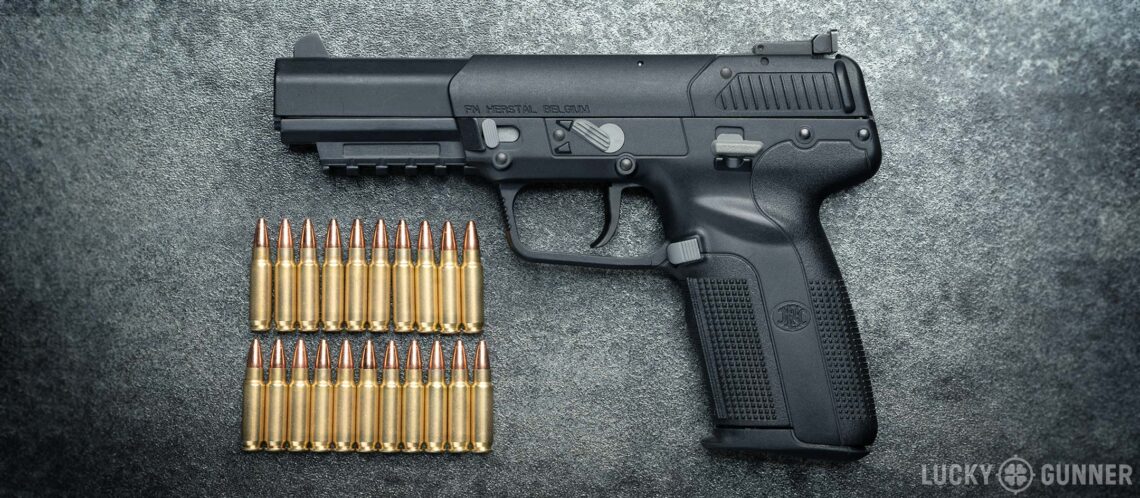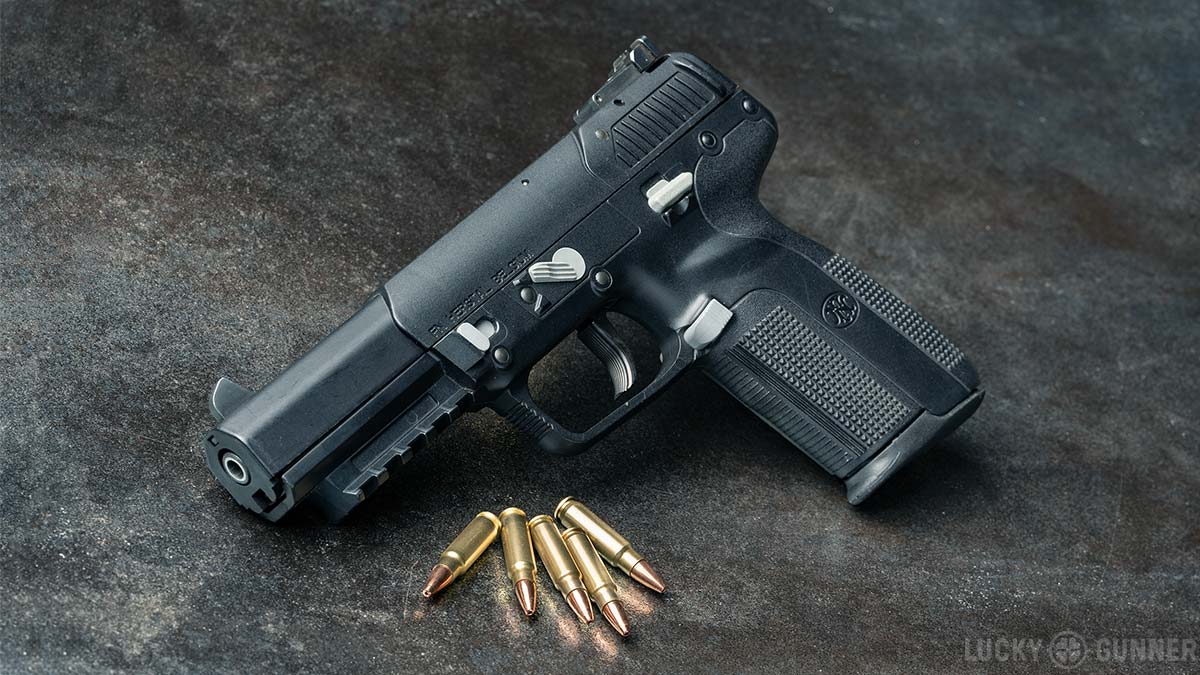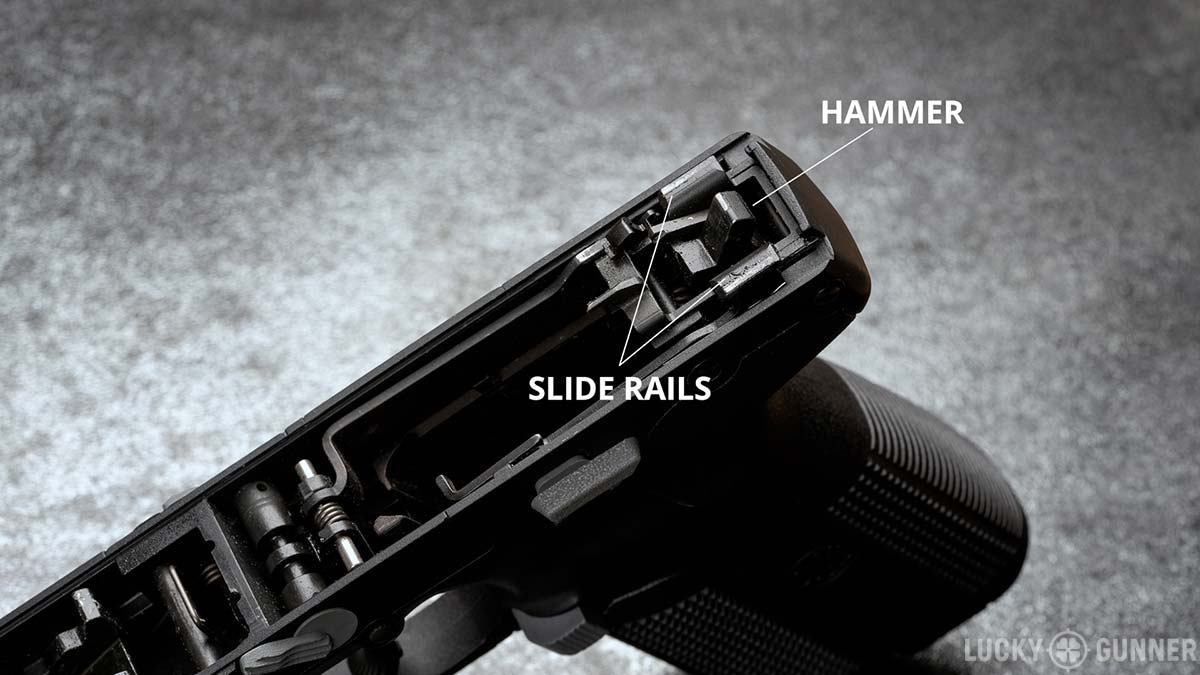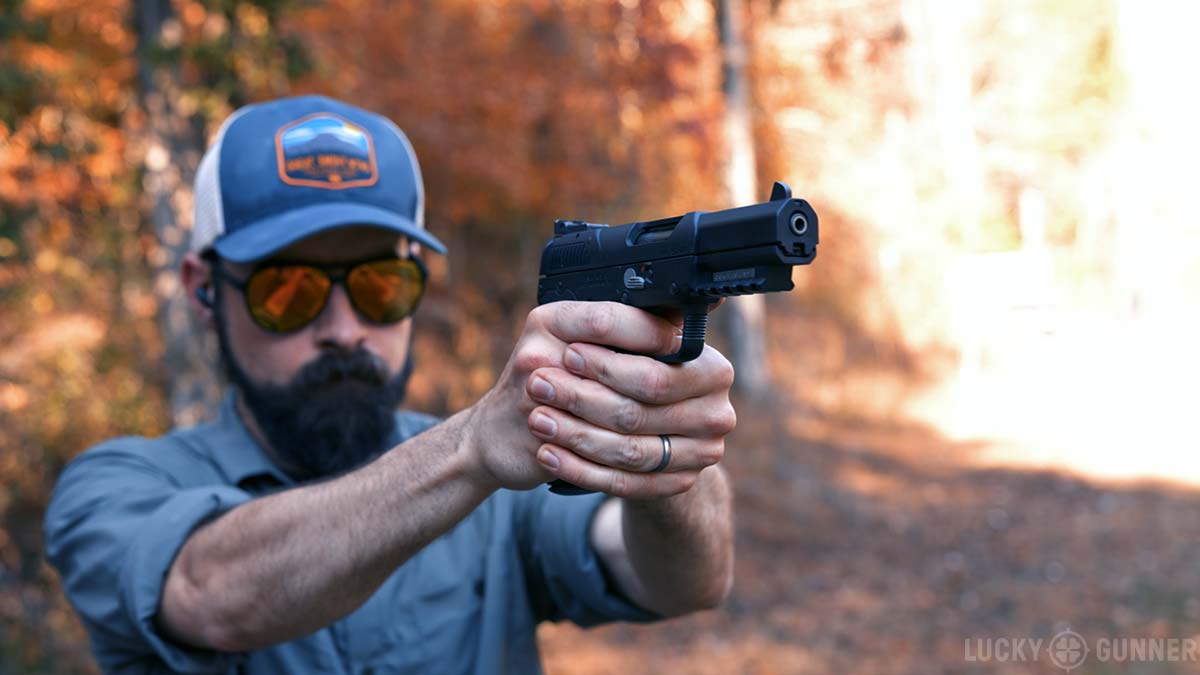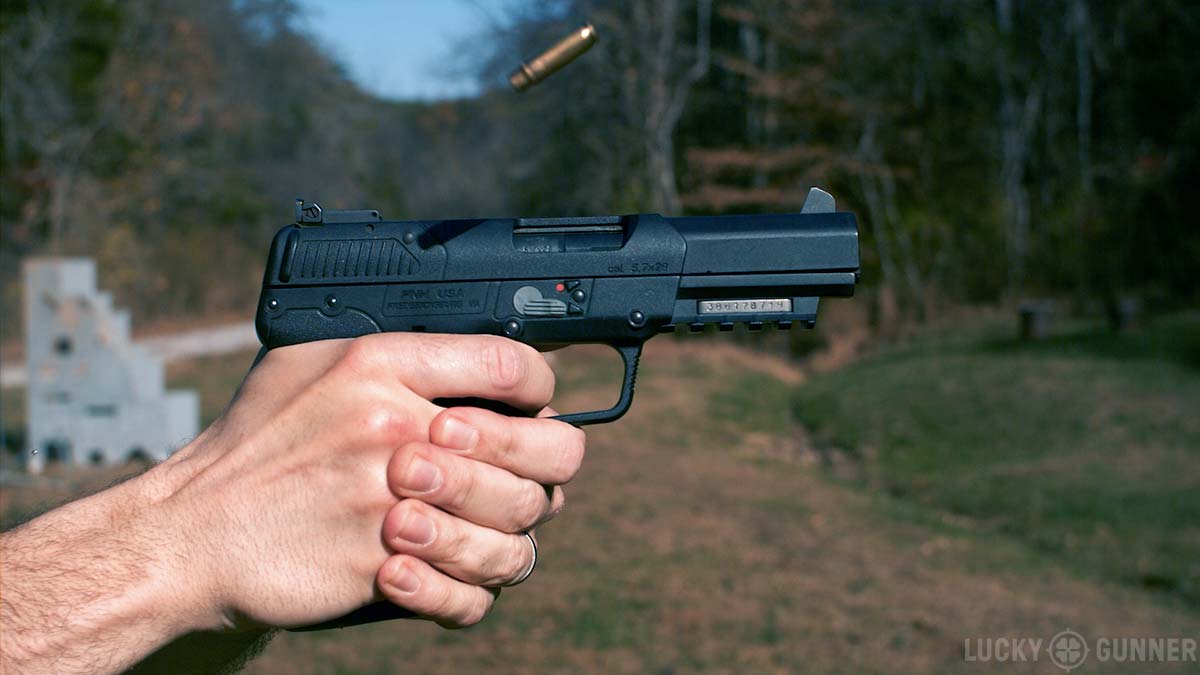The FN Five-Seven is a weird gun. In the 25 years since its debut, it’s been the subject of myths and legends perpetuated by both gun store commandos and gun control enthusiasts. Despite all of that, the Five-Seven has never become what you’d call a “popular” handgun. Today, we’re looking at what makes it the black sheep of pistols.
Details are in the video below, or keep scrolling to read the full transcript.
Hey everybody, I am Chris Baker from LuckyGunner.com and today we’re going to look at the FN Five-Seven pistol. This gun has been in the US for about 20 years now and it’s always been kind of a black sheep among duty-sized handguns. Even with the recent surge of interest in the 5.7x28mm cartridge, the Five-Seven pistol seems to be getting less attention than the newer pistols from Ruger, Smith & Wesson, and PSA that also fire that cartridge. Is the Five-Seven an underrated gem, or is its outsider status well deserved? That’s what we’re going to investigate today.
History of the FN Five-Seven
The origin of this pistol goes back to the late 1980s when NATO put out a request for a new cartridge to potentially replace 9mm. They also requested both a compact shoulder-fired weapon (what we now call a PDW) as well as a handgun to fire the new cartridge. In response, FN developed the 5.7x28mm cartridge and the P90 submachine, which both went into production in 1990. The confusingly-named FN Five-Seven handgun took a bit longer to figure out, and was finally released in 1998.
Ultimately, NATO did not decide to replace 9mm with 5.7x28mm, or any other cartridge. However, several military and law enforcement entities around the world have adopted it, along with FN’s pistol and submachine gun.
Feedback from field performance has been… mixed. But our focus today is on the pistol, not the cartridge. The fate of the two are very much intertwined, but we’ve got an entire video coming in the near future that’s all about 5.7×28 ballistics, including the results of our gelatin tests. So I’m going to hold off on any detailed discussion of the round’s capabilities until then. For now, let’s look at this gun.
Five-Seven Variants
There have been six basic versions of the FN Five-Seven produced over the years. The original 1998 model had a distinctive circular-shaped trigger guard. It was double action only with no manual safety or slide release. The only controls were a non-ambidextrous magazine release and a takedown lever. The trigger was supposedly very heavy and difficult to use. FN quickly followed that with the Five-Seven Tactical – a single action model with a slide release and an ambi safety. All subsequent variants have used a similar configuration.
Those early models were only sold to military and law enforcement for the most part. The Five-Seven first hit the US commercial market in 2004 with the IOM variant, which included a picatinny-style accessory rail, a fully adjustable rear sight, and a magazine disconnect safety. The same year, that variant was replaced with the USG, which is the variant we have here. It’s got different frame texturing, a reversible mag release, and a more conventional square trigger guard.
In 2013, FN released the Five-Seven Mk2, which you can spot by the front serrations on the slide and black controls in place of the gray ones. And in 2022, we got the Mk3 MRD. It’s got an optics-ready slide and a completely overhauled contour and texture on the frame and slide.
Basic Features
This USG variant is a bit different from the most recent model, but it’s still functionally the same pistol. So let’s take a closer look at the basic features and operation.
I’ve seen a few references to the Five-Seven as a striker-fired pistol but that is not the case. It’s internal hammer-fired and single-action only. It has an ambidextrous manual safety in the middle of the frame directly above the trigger.
It feeds from 20-round flush fit polymer-body magazines. The frame is also polymer. The slide appears to be polymer at first glance. But if you remove the slide, you can see that it’s actually steel with a kind of polymer shell around it.
While I’ve got the slide off, the internal hammer is right here. And on either side of it, we have the slide rails. That’s it. Just those two little pieces of rail for the whole slide.
FN calls the Five-Seven a delayed blowback pistol. It’s not a Browning-style locked breech pistol, nor is it a traditional straight blowback design. It uses this cam lock system that I’m not going to try to explain.
The Five-Seven is not small, even compared to other full size pistols. It’s tall and just overall feels kind of bulbous – at least this version, anyway. That makes its light weight even more surprising when you first pick it up. It’s about 20 ounces empty and 28 fully loaded. That’s around the same weight as a subcompact 9mm. The weight along with the polymer shell slide and the polymer magazine give the gun a toy-like quality. Not in a Kel-Tec kind of way… it doesn’t necessarily feel cheap, it just doesn’t seem like a real gun at first.
Unique Advantages
Until Ruger came out with their own 5.7mm pistol in 2020, the FN Five-Seven was the only commercially available handgun chambered for that cartridge. In the early 2000s, there was a lot of mystery surrounding both the pistol and the ammo. They were considered kind of exotic. Most gun enthusiasts had never even seen a Five-Seven in person, let alone had the chance to shoot one. There were all kinds of rumors about its armor-piercing capabilities. The ATF only added to the mystique when they made a big fuss about which 5.7×28 loads were and were not legally considered armor piercing.
Realistically, the Five-Seven had two genuinely unique advantages for the average armed citizen that set it apart from other handguns of the time. First was the 20-round mag capacity. Today, you can get extended 20 and even 30-round magazines for just about every full size 9mm pistol out there. But in the days after the Federal Assault Weapons Ban expired, those were not readily available. A 20-round flush-fitting magazine was a major selling point.
The other big advantage was the exceptionally low recoil. It fires small diameter, lightweight bullets at high velocity and that translates to very little felt recoil and minimal muzzle rise. FN claims it has 40% less recoil than a 9mm, and that sounds about right. It’s an easy gun to shoot. It’s easy for beginners to get the hang of. And until you remember how much you’re paying for ammo, it’s a lot of fun at the range.
You could also argue that the Five-Seven is exceptionally accurate for a handgun. The 5.7×28 cartridge is inherently accurate and has a flatter trajectory than most pistol rounds. However, the Five-Seven is a less than stellar long range target pistol thanks to a mediocre trigger (which I’ll come back to in a minute).
Less Than Ideal
The FN Five-Seven has remained in production for 25 years now, and it’s got some fans, but it’s never really caught on. Why is that?
You could blame it on the fact that it fires an odd cartridge that, until recently, was only shared by the sad, civilian-legal, neutered version of the P90 submachine gun (dubbed the PS90). 5.7x28mm ammo is expensive, not many companies make it, and supply is not always plentiful. That’s starting to change and it’s gotten a little more attention recently, but for now, it’s still a relatively obscure cartridge.
Aside from the cartridge, the pistol itself has a few less than ideal design features. Because of the length of the cartridge, the grip is an awkward shape. It feels very blocky. I imagine FN has improved that on the Mk3, but it’s just not possible for the grip to have the same ergonomic shape as a typical full size 9mm pistol.
The trigger stroke also feels a bit strange. It’s got a little slack and then you hit firm resistance. Zero creep until it breaks at about six pounds. That’s on the heavy side for a single action. I think it feels awkward. It detracts somewhat from the gun’s overall shootability. Yes, there’s very little recoil, but the trigger requires some extra attention in order to get the kind of rapid fire accuracy that’s possible with a low recoiling pistol.
By far the most unconventional feature is the manual safety. You activate it with your trigger finger, or your support hand thumb if you use a thumbs-forward style grip. If you’re used to the manual safety on pretty much any other modern handgun, this is just plain weird. But if you think about it, it’s really not a bad design, theoretically. The safety is right here above the trigger, so as you sweep it off, you can just keep going down to the trigger. When you stage your finger to operate the safety, it’s automatically in a high register position, which is ideally where it should be anyway until you’re ready to shoot. Whether you’re coming out of the holster or from a ready position, that safety facilitates good trigger finger discipline. But it definitely takes some getting used to.
Weird Doesn’t Come Cheap
More than any of that stuff, the one thing that’s probably hurt the Five-Seven’s chances at mainstream success is the price tag. The MSRP of the newest model is $1500. It’s been lower at times in the past, but even back in the early 2000s, I think it was at least $1000. It’s never been affordable, especially for a polymer framed gun. In fact, I think it’s likely that the high cost of the pistol discouraged people from trying out the 5.7mm cartridge rather than the other way around. Now that we’ve got pistols in that caliber in the $400-700 range along with a few carbines, more people are willing to take a chance on adding a new cartridge to their collection, and it’s finally gained a little traction.
The FN Five-Seven is not a bad pistol. It may even be marginally better than the other 5.7mm pistols on the market in some respects. But it’s still… nothing special. If it was a 9mm, nobody would have looked at it twice, and FN would have pulled it from their lineup years ago. The Five-Seven has only ever been interesting because of the caliber it fires, and now that it’s lost the exclusive claim to that caliber, it’s tough to justify its quirks, let alone the cost.
Of course, that’s still just half the story. Stay tuned for our deep dive into 5.7x28mm ballistics. We’re hoping to get that out by the end of the year. In the meantime, we’re going to cover some other topics you guys have been asking about. And some you haven’t. And as always, the next time you need some ammo, be sure to get it from us with lightning fast shipping at LuckyGunner.com.
